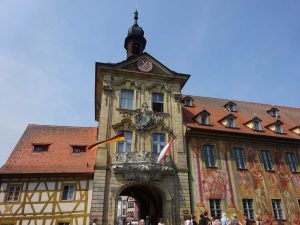A Danube River Cruise in Bamberg, Germany will give you glimpses of well-preserved buildings. One of these buildings is the Bamberger Dom (Official name is Bamberger Dom St. Peter und St Georg. Also dubbed as the Bamberger Cathedral, it’s a must-visit site for many reasons. Since 1993, the cathedral has been part of the UNESCO World Heritage Site “Town of Bamberg”.
History Encompassing Two Millennia
Before he became a king and an emperor, Heinrich II had his favorite home in Bamberg. Years later, he offered the property as a gift to his wife, Cunigunde.
Around 1002, Heinrich II became Germany’s King. He liked Bamberg so much that he did most of his governing duties therein. Aside from his fondness for the town, he and his wife were known for being pious. It wasn’t a surprise when they initiated the creation of a diocese in Bamberg.
Building began in the same year. It was declared holy on May 6, 1012, as part of the founder’s birthday celebration.
However, the initial cathedral was burned down decades later. It was replaced but it was also destroyed by fire. The current structure was built in the 1200s.
The Remaining Germany-Based Papal Grave
It’s known that many popes are buried in Italy, specifically in Rome. However, not all former popes are buried therein. Some papal graves are in France. There’s also one in Bamberg, Germany.
Before the 1800s, two papal graves were situated in Germany. The first one is that of Pope Clement II. Before he became the leader of the entire Catholic Church, he served as bishop of Bamberg. His body was first buried in Rome but was eventually moved to Bamberger Dom. The marble tomb of Clemens II is located in the west choir.
The second Germany-based papal grave belonged to Pope Benedict V. His tomb was in Hamburg. However, it was destroyed around the 1800s. This left Pope Clement II’s tomb the only other papal grave that was not based in Italy or France.
The Tomb of the Imperial Couple Turned Saints
The bishops of neighboring dioceses opposed the creation of the initial Bamberg diocese. However, then-king Heinrich II insisted.
Twelve years after becoming a king, Heinrich II was recognized as the Holy Roman Emperor. When he died in 1024, his wife planned his interment in the Bamberg Cathedral. Almost 16 years later, Empress Cunigunde also died. She and her husband shared a carved, marble tomb splendidly carved by Tilmann Riemenschneider.
The imperial couple didn’t have a child. As a result, the Ottonian dynasty of Emperors ceased to exist.
Nevertheless, the legacy of the former emperor and empress lives on. The Bamberg Cathedral is among the reminders of their contributions. Moreover, they were also canonized as saints by the Roman Church.
Works of Art
The cathedral itself is a work of art. Romanesque and Gothic styles were used in designing the structure. Aside from this, the sculptures you can find in the famed tombs are also worth seeing. The statues are noteworthy for their refined details as well. The most noteworthy treasure is the slender equestrian statue of the Bamberger Reiter (Bamberg Horseman), whose identity remains a mystery. This statue, possibly depicting the Hungarian king Stephen I, most likely dates to the period from 1225 to 1237. The Reiter is probably the oldest statue of a horseman created in post-Roman Germany. Nearby, the Virgin Mary altar by Veit Stoss also warrants closer inspection.
Bamberger Dom is among the best sites to visit, not just in the town of Bamberg, but in the entire German country. Everyone can bask in the solemnness the cathedral and its rich history offer. You can also enjoy the breathtaking architecture, sculpture and other works of art you can see therein.
Bamberg is a stop offered on river cruises itineraries that feature a Main and Danube River itinerary. Featured cruises are AmaWaterways Medieval Treasures; Europe’s Rivers & Castles; as well as the 14-night Magnificent Europe. Arosa’s “Romance on the Rhine” cruising between Cologne and Engelhartszell, Austria as well as Cologne and Regensburg also makes a stop in Bamburg.
Europeanbarging can assist with finding the perfect river cruise for you. Contact them for promotional offers and details on payment plans. Europeanbarging are barge and river cruise specialist since 1998. For more information: jan@europeanbarging.com 888-869-7907


